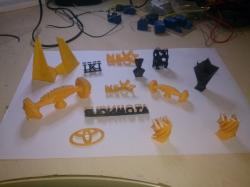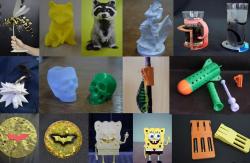 3D Printed Models
3D Printed Models  3D printed models
3D printed models 3D printed models
3D printed models 3D PRINTED MODELS
3D PRINTED MODELS MEADS 3D Printed Models
MEADS 3D Printed Models 3d printed vase
3d printed vaseDiscovering 3D Printed Vase Models
3D printed vases offer a blend of traditional craftsmanship and modern technology. Various platforms provide a plethora of designs ranging from simple and elegant to complex and avant-garde. Websites like Cults3D, CGTrader, and MyMiniFactory are treasure troves of 3D vase models. These models come in various file formats like STL, OBJ, and more, catering to different 3D printing technologies.
The variety of designs is staggering. You can find everything from minimalist shapes to intricate patterns inspired by nature, geometric forms, or even abstract art. For instance, the “Voronoi vase” and the “Apex 3D Vase” are examples of how diverse these designs can be, reflecting anything from mathematical patterns to natural landscapes.
3D Printing Techniques for Vases
Choosing the Right Material
When it comes to materials, you have several options. PLA is a popular choice due to its ease of use and vibrant color options. However, for a more traditional, ceramic-like feel, you might consider ceramic resins. Each material brings its own set of properties and aesthetic appeals.
Printing Tips
- Infill and Thickness: To ensure your vase is watertight, especially if you plan to use it for real plants, opt for a higher infill percentage (at least 15%) and continuous extrusion to prevent leaks.
- Scaling and Customization: Most vase models are scalable, allowing you to adjust their size to fit your space perfectly. You can also modify the design using slicing software to suit specific needs, such as adding a bottom if the model is bottomless.
- Post-Processing: After printing, you might want to sand, paint, or seal your vase to enhance its appearance and functionality. For instance, a simple PLA vase can be painted to mimic a ceramic look or sealed to become more water-resistant.
Q&A on 3D Printed Vases
Do 3D Printed Vases Leak?
Yes, they can if not printed with the right settings. To prevent leakage, use a higher infill and ensure continuous extrusion. Over time, however, most filaments, especially PLA, may absorb water and degrade. To mitigate this, seal your vase or choose a more water-resistant material.
Can You Use PLA for Flower Vases?
Yes, PLA can be used for flower vases if printed thick enough to be watertight. However, be aware that PLA isn’t inherently water-resistant and might degrade over time.
How Do You Make a 3D Printed Vase Watertight?
To make a 3D printed vase watertight, increase the infill and wall thickness. Additionally, applying a sealant or using a water-resistant filament can enhance its water-holding capability.
Final Thoughts
3D printed vases represent a blend of artistic expression and technological innovation. They offer endless possibilities for customization and can be a unique addition to any interior. Whether you’re a seasoned 3D printing enthusiast or a curious beginner, the world of 3D printed vases is an exciting realm to explore. Remember, the key to a successful 3D printed vase lies in choosing the right design, material, and printing settings to suit your specific needs and aesthetic preferences.
